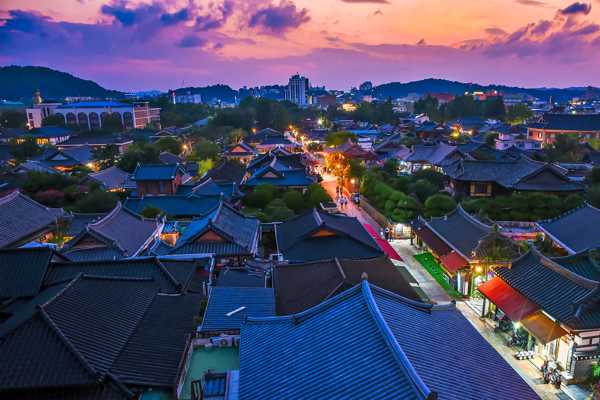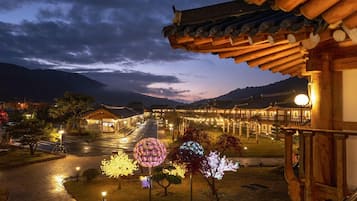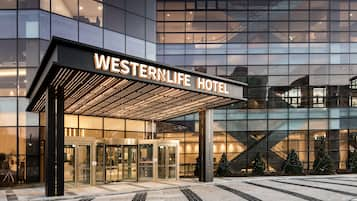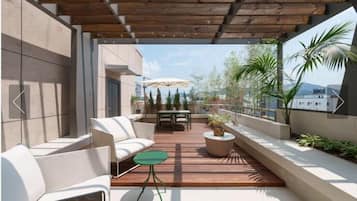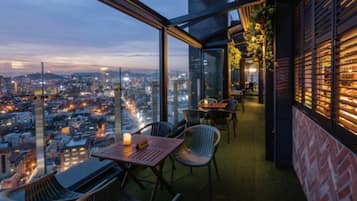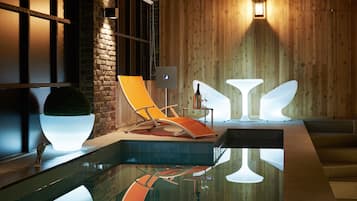The best things to do in Jeonju encompass gastronomy, history, and culture. Designated as a UNESCO City of Gastronomy, this South Korean destination has inherited and developed not only history but also traditional villages, local food, and intangible cultural assets that make up the country’s unique culture.
Must-visits include the Jeonju Hanok Village, where around 700 houses densely populate the area, and historical sites following the traces of King Taejo Yi Seong-gye, the founder of the Joseon Dynasty. You can also stop by the Royal Portrait Museum, which enshrines the portrait of Taejo Yi Seong-gye. There is also the Jaman Mural Village, decorated with warm and emotional murals in a neighbourhood formed by Korean War refugees. Witness and experience the diverse appeals of Jeonju yourself.
- 1
Jeonju Hanok Village
Where you can vividly experience traditional culture

- Pasangan
- Keluarga
- Makanan
- Sejarah
Jeonju Hanok Village is where around 700 hanok buildings form a colony in the centre of the downtown area of Jeonju and, here, you can experience traditional culture through your five senses. There are various facilities including a culture hall, training centre, history hall, calligraphy hall, literature hall and museum situated inside Hanok Village to educate visitors on traditional culture, so you will be able to gain in-depth knowledge in different fields of your interest. Since Jeonju is the hometown of King Taejo Yi Seong-gye who founded Joseon, it is also meaningful to follow the traces of King Taejo.
If you had a day full of culture and history in Hanok Village, fill your stomach with local foods, various delicacies and old-fashion snacks at the marketplace and night market where you can also check out the wonderful works of handicraft artists. We recommend you finish the day by enjoying the beautiful view featuring Cheongsachorong and lights that illuminate Hanok Village at night.
Lokasi: 99, Girin-daero, Wansan-gu, Jeonju-si, Jeollabuk-do, Republic of Korea
Telefon: +82 (0)63-282-1330
Peta - 2
Royal Portrait Museum
Museum where you can find portraits of kings

- Pasangan
- Keluarga
- Sejarah
The Royal Portrait Museum displays portraits of the kings of the Joseon Dynasty and, thus, answers your questions about the appearance of the kings of Joseon. We highly recommend you to visit as you can check out unique artefacts here that you will not find anywhere else.
The exhibition rooms where the kings’ portraits are exhibited are divided into one for Taejo and the other for the other kings. The royal portrait of Taejo in the centre of his royal portrait exhibition room shows him wearing a blue royal robe and it is said that this is because he was the king who founded a new country. The other royal portrait room enshrines portraits of seven other kings - Sejong, Yeongjo, Joengjo, Cheoljong, Gojong and Sunjong. Among them, the royal portraits of Sejong and Jeongjo are composite paintings while those of Gojong and Sunjong are paintings created from photographs. Don’t miss the rare opportunity to look at portraits of kings up close.
Lokasi: 44, Taejo-ro, Wansan-gu, Jeonju-si, Jeollabuk-do, Republic of Korea
Buka: November–February: daily from 9 am to 6 pm. March–May and September–October: daily from 9 am to 7 pm. June–August: daily from 9 am to 8 pm
Telefon: +82 (0)63-231-0090
Petafoto oleh 채용신 (CC BY-SA 4.0) diubah suai
- 3
Gyeonggijeon Shrine
Place that enshrines the portrait of a dynasty founder

- Pasangan
- Keluarga
- Sejarah
Gyeonggijeon Shrine is the place where the portrait of King Taejo Yi Seong-gye, the founder of the Joseon Dynasty, is enshrined and where you can feel the pride of Joseon. In front of Gyeonggijeon, a stone stele known as Hamabi is erected to signify that everyone who passes the shrine must dismount from their horse and pay respects. It has a greater historical value as it has a unique form different from other Hamabi Steles.
After passing through Hamabi and then an entrance featuring three gates, you will find Red Hongsalmun Gate, which indicates that it is a sacred place. If you walk up to the Main Hall of Gyeonggijeon, you will find the portrait of King Taejo Yi Seong-gye. The portrait is quite significant because this is the only remaining portrait after all the others were burned and destroyed during the Japanese Invasion in 1592. Feel the sacred energy of the Joseon Dynasty, which ruled for 500 years, along with the solemn portrait of Yi Seong-gye who founded Joseon.
Lokasi: 44, Taejo-ro, Wansan-gu, Jeonju-si, Jeollabuk-do, Republic of Korea
Buka: Daily from 9 am to 7 pm
Telefon: +82 (0)63-281-2788
Peta - 4
Omokdae Historic Site
Place that contains the ambition of a king for a new country

- Pasangan
- Keluarga
- Sejarah
Omokdae Historic Site is famous as a place where you can get the best views of Jeonju Hanok Village. Back in history, this was where Yi Seong-gye, before he founded Joseon, held a banquet in Jeonju on his march to Kaesong, the capital of Goryeo at the time, after defeating Japanese raiders in Hwangsan. It is said that Yi Seong-gye expressed his ambition to build a new country by reciting the Song of the Great Wind, a song originally sung by Liu Bang, the founder of the Han Dynasty.
Omokdae, which is full of interesting stories, is located on a low hill making it easy to climb. The leaves that turn beautifully in autumn are especially gorgeous here. You will be able to get to Omokdae by taking a light stroll and, once you walk up to the pavilion built upon it, you can enjoy the panoramic view of Hanok Village. The scenery you see during the day is also beautiful but, as soon as you experience the night view lit up by hanok buildings huddled together late in the evening, you will be able to make even more unforgettable memories.
Lokasi: 55, Girin-daero, Wansan-gu, Jeonju-si, Jeollabuk-do, Republic of Korea
Telefon: +82 (0)63-232-2255
Peta - 5
Wansan Park
Park from which you can overlook the downtown area in a single view

- Pasangan
- Keluarga
Wansan Park is situated on Wansanchilbong Peak, also known as the essence of Jeonju, and is a friendly place where citizens visit regularly. Wansan Park is a part of a mountain range that runs along Jeonjucheon Stream that crosses the city of Jeonju and is widely used as a hiking trail and a resting area.
On the way up to the park, you can catch sight of Geumsongaji Rock, which has an interesting unofficial history. You will also come across the Donghak Peasant Army Jeonju Arrival Monument built at a historical site of the Donghak Peasant Revolution. If you make your way up to the octagonal pavilion on Janggunbong Peak, you will be able to enjoy a panoramic view of Jeonju. Downtown Jeonju, its surrounding mountains and, even, Moaksan Mountain in the distance will be spread out underneath your feet. Mountain cherry blossoms and azaleas are in full bloom in spring so you can enjoy a spring outing in the midst of beautiful scenery. Escape from your weary daily life and feel the freshness of nature at Wansan Park.
Lokasi: 19-4, Gongsunae 1-gil, Wansan-gu, Jeonju-si, Jeollabuk-do, Republic of Korea
Telefon: +82 (0)63-220-5438
Peta - 6
Nambu Traditional Market
Market filled with things to eat and see

- Pasangan
- Keluarga
- Makanan
- Pembeli-belah
Nambu Traditional Market is a good place to check out after visiting Jeonju Hanok Village when you want to get a glimpse of the daily lives of Jeonju citizens. The market is located right across the street from Hanok Village and nearby attractions include Jeonju Hyanggyo, Jeondong Cathedral, Gyeonggijeon Shrine and Pungnammun Gate. It is also a site of 100-year history that has shared the joys and sorrows of the modern era with the people of Jeonju.
Most of the typical traditional markets close around sunset but Nambu Traditional Market runs a night market up to midnight, which allows you to enjoy delicious foods until late. You can taste various dishes primarily from local foods and exotic delicacies to world-class cuisine. There are many other things to see as well a flea market where local artists and residents participate along with cultural performances and events. Don’t miss out on the Nambu Traditional Market if you want to experience a dynamic, lively atmosphere.
Lokasi: 19-3, Pungnammun 1-gil, Wansan-gu, Jeonju-si, Jeollabuk-do, Republic of Korea
Buka: Daily from 9.30 am to 10 pm (varies by store)
Telefon: +82 (0)63-284-1344
Peta - 7
Jeonju World Cup Stadium
Unique football stadium that embodies tradition

- Pasangan
- Keluarga
Jeonju World Cup Stadium is a football-only stadium constructed to host the 2002 World Cup. Today, it is used as the home stadium of Jeonbuk Hyundai Motors and, here, you can watch a football match up close. Fitting for a city of history, Jeonju is home to a stadium that features pillars embodying Hapjukseon ships and those symbolising sotdae as well as cables representing the 12 strings of gayageum that support the roof. The entrance even looks like a fortress gate, which is why it is nicknamed “Jeonjuseong Fortress” by locals.
As Jeonbuk Hyundai Motors, the team that uses the stadium as the home field, is one of the powerhouses in the Korean football league, the stadium fills with passionate fans. Make sure to stop by to catch a quality match when you visit. There is a temporary express bus terminal stop right next to the stadium, which makes it convenient for people from other cities to come watch games.
Lokasi: 1055, Girin-daero, Deokjin-gu, Jeonju-si, Jeollabuk-do, Republic of Korea
Buka: Daily from 6 am to 11 pm
Telefon: +82 (0)63-239-2546
Petafoto oleh 한영태 (CC BY-SA 4.0) diubah suai
- 8
Deokjin Park
Lake park where you can see beautiful lotus flowers

- Pasangan
- Keluarga
Deokjin Park, located in the centre of downtown Jeonju, is an ecological and cultural park that many people visit because of its vast cluster of lotus flowers. In the park, there is a huge lake called Deokjinho, around which an octagonal pavilion, bridge and observatory are installed. Monuments commemorating writers who have brought honour to the contemporary literature of North Jeolla Province are installed throughout the park, adding a romantic mood.
From July to August, lotus flowers filling Deokjinho produce a spectacular view. Light pink and white lotus flowers blossom brightly, and attract visitors with their colourful appearance and subtle scents. The scenery that encompasses everything from the bridge across the flower-filled lake to the octagonal pavilion is so beautiful that you will not want to miss it. Why don’t you stop by Deokjin Park with your loved ones and have a romantic and beautiful time?
Lokasi: 390, Gwonsamdeuk-ro, Deokjin-gu, Jeonju-si, Jeollabuk-do, Republic of Korea
Telefon: +82 (0)63-239-2607
Peta - 9
Jeonju Kimchi Culture Centre
Culture centre with the themes of representative Korean foods

- Pasangan
- Keluarga
- Makanan
- Luar biasa
Jeonju Kimchi Culture Centre is a place where you can learn about the history and culture of Kimchi, which has a special place in Korean food culture. A Creative City of Gastronomy designated by UNESCO, Jeonju is a town of “taste” and “style” full of heritage of tradition, culture and arts. It is even more meaningful that the Kimchi Culture Centre was established in this city.
Jeonju Kimchi Culture Centre has an exhibition hall located inside a hanok building. If you go inside the hanok, you will learn about the culture of Kimchi that you always accompany in your daily life but you’ve never known too much about, from the history and different types of Kimchi to the story behind kimjang, or kimchi making. It would be nice to sit and take a rest on the toenmaru and then check out the crocks in the backyard. There are also many hands-on programs through which you can make your own Kimchi or learn about Kimchi, so don’t miss out if you are interested.
Lokasi: 29, Eojin-gil, Wansan-gu, Jeonju-si, Jeollabuk-do, Republic of Korea
Buka: Tuesday–Sunday from 9 am to 6 pm
Telefon: +82 (0)63-287-6300
Peta - 10
Jaman Mural Village
Village that welcomes visitors with heartwarming and sentimental murals
- Pasangan
- Keluarga
- Sejarah
- Foto
Jaman Mural Village is a place where you can see colourful murals and access the famous rooftop garden from which you can enjoy a wide open view of downtown Jeonju. Jaman Mural Village faces Jeonju Hanok Village from across the street, and it was originally a poor hillside village formed by refugees during the Korean War. As warm and lively murals started to be painted on houses in the alleys in 2012, it has been reborn as a famous tourist spot.
It is nice to take a look around at nearby cultural properties and attractions at the same time due to its proximity of simply crossing an overpass from Jeonju Hanok Village. Around 30 minutes is more than enough to complete your tour, so you can visit the place with a light heart. It is also fun to check out the various styles of murals as you walk through the alleys. Recharge yourself with warm feelings in the mural village, which is designed to harmonise with the surrounding scenery through cartoons and fairy tales.
Lokasi: Gyo-dong, Wansan-gu, Jeonju-si, Jeollabuk-do, Republic of Korea
Peta

